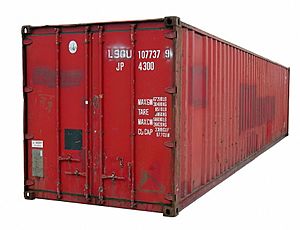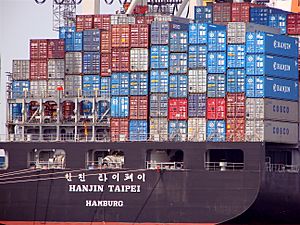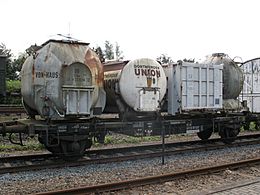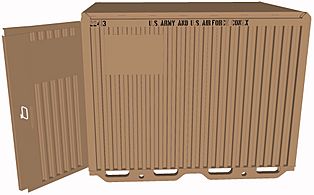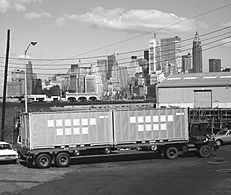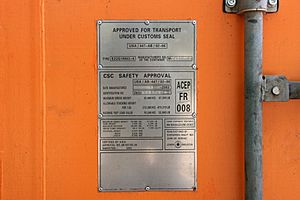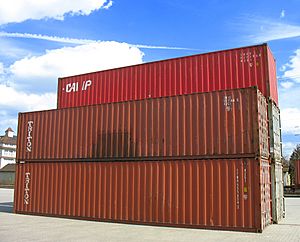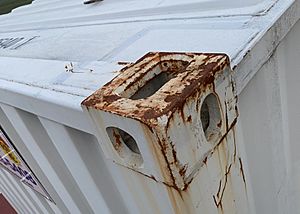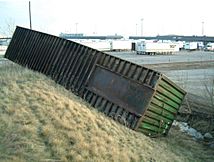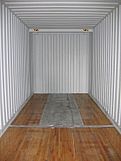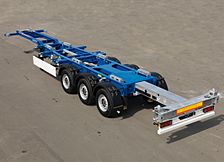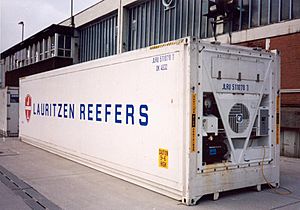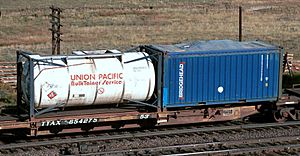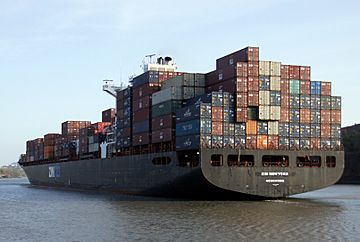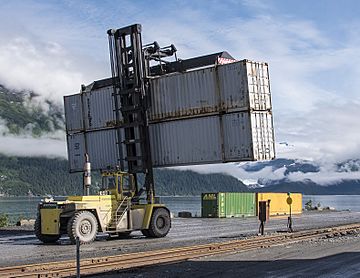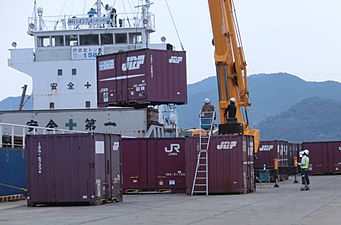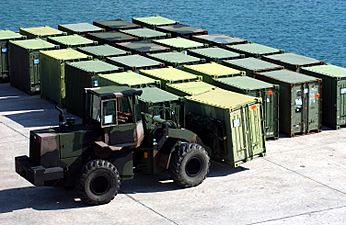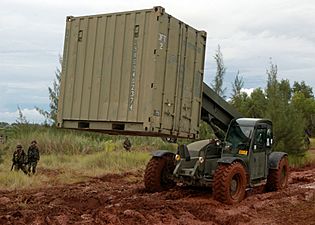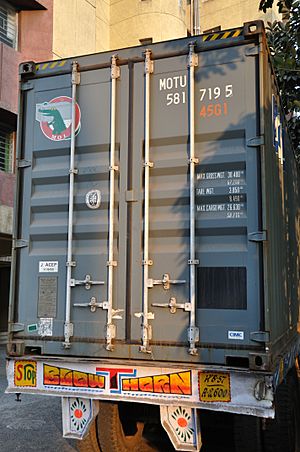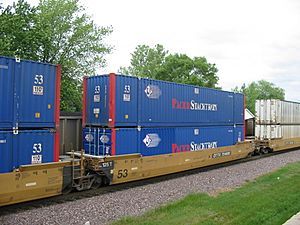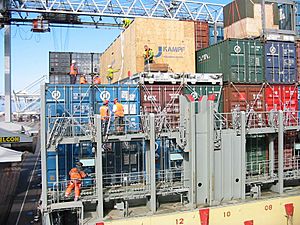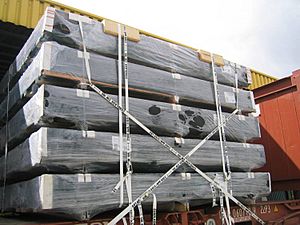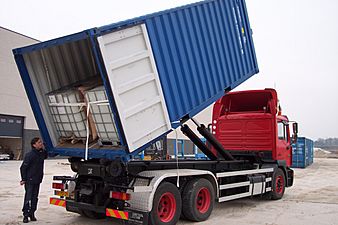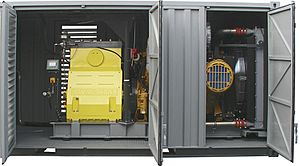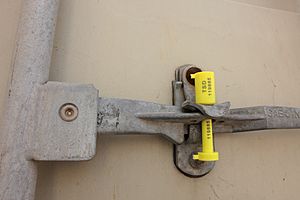Intermodal container facts for kids
An intermodal container, often called a shipping container, is a big, strong box. It's built to move goods easily using different types of transport. This means the same container can go from a container ship to a train and then to a truck. You don't have to unload and reload the items inside. These containers are super important for moving products around the world safely and efficiently. Most of them follow special rules set by the International Organization for Standardization (ISO). That's why they are often called ISO containers. You might also hear them called cargo containers, freight containers, or sea cans. The term CONEX box is an old name for a smaller, earlier type of container used by the U.S. Army.
Intermodal containers come in many types and sizes. But about 90% of all containers are "dry freight" or "general purpose" containers. These are tough, closed rectangular boxes made of special steel that resists rust. They are almost always 8 feet (2.4 m) wide. Their standard lengths are either 20 feet (6.1 m) or 40 feet (12.2 m), as set by ISO standards. Some containers are taller, at 9 feet 6 inches (2.9 m), and are called High Cube containers.
These containers were first thought of in the early 1900s. The modern 40-foot containers became popular in the 1960s and 1970s. This happened thanks to a shipping company called SeaLand. Just like cardboard boxes, containers help group many items together into one big load. This makes them easy to handle, move, and stack. They fit tightly on ships or in storage yards. All intermodal containers have special features to handle the tough conditions of shipping. They also have a unique ISO 6346 code to identify them.
In 2012, there were about 20.5 million intermodal containers worldwide. They come in different types for different kinds of cargo. Containers have mostly replaced the old way of shipping items one by one. By 2010, containers carried 60% of the world's goods moved by sea. For shipping by air, lighter containers called unit load devices are used.
Contents
- How Shipping Containers Started
- Container Features
- Different Container Types
- Container Sizes and Details
- Other Container Sizes
- Smaller Containers
- Container Identification
- Moving Containers Around
- How Containers are Transported
- Keeping Containers and Contents Safe
- Other Uses for Containers
- International Standards for Containers
- More About Containers
How Shipping Containers Started
Early Container Ideas
The idea of containerization began in England in the late 1700s. People used wooden boxes to move coal on canals. For example, in 1766, James Brindley designed boats with ten wooden containers to carry coal. By the 1830s, railroads were using containers that could be moved to other types of transport. The Liverpool and Manchester Railway used "simple rectangular timber boxes" to move coal. These boxes were then lifted by cranes onto horse-drawn carriages. By the 1840s, iron boxes were also used. In the early 1900s, closed containers were designed to move easily between roads and railways.
Creating Global Standards
The first international rules for containers were made in 1933. A second set of rules came out in 1935. These were mainly for transport between European countries. American containers at this time were not standardized. Also, these early containers could not be stacked. In 1932, the first container terminal opened in Enola, Pennsylvania. Containerization grew in Europe and the US to help train companies after the economic crash of 1929.
Mid-1900s Container Changes
In 1951, a system for containers was chosen for Western Europe. It was based on a Dutch system called Laadkisten (meaning "Loading chests"). This system used containers that could be moved by rail, truck, and ship. It became the first standard for European railways after World War II.
The use of standardized steel containers started in the late 1940s and early 1950s. This is when shipping companies and the US military began to develop them. In 1948, the U.S. Army created the "Transporter." This was a strong steel container that could carry 9,000 pounds (4,082 kg). It was 8 feet 6 inches (2.6 m) long and had lifting rings on its corners. After working well in Korea, the Transporter became the (CONEX) box system in 1952. CONEX boxes could be stacked three high. By 1965, the US military used about 100,000 CONEX boxes. This was the first time intermodal containers were used widely around the world. Their invention greatly helped global trade by making shipping much cheaper.
Starting in 1949, an engineer named Keith Tantlinger helped a lot with container development. In 1955, a trucking boss named Malcom McLean bought a shipping company. He hired Keith Tantlinger. Together, they developed a new 35-foot (10.7 m) Sea-Land container. This container had a strong frame with eight corner parts for stacking. Tantlinger also designed special equipment to handle containers and the twistlock system to connect them.
Modern Container Design
Modern containers, like the ones we see today, became widely used around 1956. Businesses started to create organized ways to use and benefit from shipping containers. As telecommunications improved in the late 1900s, it became even more helpful to have standardized containers. This made shipping processes more organized and easier to manage.
After McLean's first container ship, the Ideal X, started shipping on the US East Coast, another company, Matson Navigation, followed. Matson's containers were 8 feet (2.4 m) wide and 8 feet 6 inches (2.6 m) high. But because of California's different traffic rules, Matson made their containers 24 feet (7.3 m) long. In 1968, McLean started container service for the US military in South Vietnam, which was very successful.
Today's ISO Standards
The ISO standards for containers were published between 1968 and 1970. These rules help make sure containers are loaded, transported, and unloaded the same way in ports worldwide. This saves time and resources.
The International Convention for Safe Containers is a rule from 1972. It says that every container traveling internationally must have a special "CSC Safety-approval Plate." This plate has important information about the container. It includes its age, registration number, size, weight limits, and how much it can be stacked.
How Containers Changed Jobs
This new way of shipping goods caused challenges for dockworkers and their unions. For example, by 1971, a rule said that filling or emptying a container within 50 miles (80 km) of a port had to be done by union workers. If not, the shipping company had to pay fees to the union. Other unions argued that this rule was unfair. In 1980, the Supreme Court of the United States ruled against the dockworkers' union.
Containers and Supply Shortages
Some experts say that shipping containers have also caused problems. They might have made the 2021 global supply chain crisis worse in 2020 and 2021. This led to many shortages related to the COVID-19 pandemic. The problem is that the container shipping process is very connected. If there's a delay or problem at one point, it can cause big delays everywhere else.
In January 2021, a shortage of shipping containers at ports caused shipping to get backed up.
Marc Levinson, an author who wrote about shipping containers, explained: "Because of delays, it's taking a container longer to go from where it starts to where it's unloaded. So, the container is used for longer on each trip. This means a lot of the total shipping capacity is lost because containers can't be used as often."
He also noted that shipping companies often charge more to send containers from Asia to North America than the other way around. This means that sometimes, empty containers are sent back to Asia instead of being used to ship goods from the US. This makes it hard for US farmers and other exporters to find containers for their products.
Container Features
Most containers are "dry freight" or "general purpose" types. They come in standard and special sizes. About 80% of the world's containers are either 20 or 40 feet long. These typical containers are rectangular boxes with doors at one end. They are made of weathering steel (called CorTen) with a plywood floor. The wavy sides and roof make the container strong for stacking. However, these wavy sides can also cause more air resistance for trucks or trains.
Standard containers are 8 feet (2.4 m) wide and 8 feet 6 inches (2.6 m) high. But taller "High Cube" containers, which are 9 feet 6 inches (2.9 m) high, are now very common. By the end of 2013, high-cube 40-foot containers made up almost half of the world's shipping containers.
About 90% of containers are either 20 feet or 40 feet long. However, the United States and Canada also use longer containers, like 45 feet (13.7 m), 48 feet (14.6 m), and 53 feet (16.2 m). ISO containers have special openings called "castings" at each of their eight corners. These openings are for twistlock fasteners. They allow machines to grab the box from above, below, or the side. Containers can be stacked up to ten units high.
Even though ISO standards only required nine-high stacking, some very large container ships now stack them ten or eleven high. Some ships even stack them up to twenty-one high from the bottom of the hull! This needs careful planning to make sure heavier containers are at the bottom for stability.
Regional containers, like those in Europe, Japan, and the U.S., are mainly moved by road and rail. They can usually only be stacked two or three high when full. Containers can bend a little during transport.
Container capacity is often measured in twenty-foot equivalent units (TEU). One TEU is the capacity of one standard 20-foot long container. This is a rough measure, as it doesn't consider the height. For example, a 9-foot 6-inch tall high-cube container and a 4-foot 3-inch half-height 20-foot container are both counted as one TEU. Similarly, extra-long 45-foot containers are usually counted as two TEU, just like standard 40-foot units. Two TEU equals one forty-foot equivalent unit (FEU).
In 2014, the total number of containers worldwide grew to 36.6 million TEU. For the first time, 40-foot High-Cube containers made up most of the containers in use. In the 21st century, the market has shifted to using 40-foot high-cube dry and refrigerated containers more and more. Forty-foot units have become so standard that shipping companies charge only slightly more to move a 40-foot unit than a 20-foot unit. Even though 20-foot units often carry heavy cargo and help balance ships, carriers sometimes charge more per TEU for them.
For container makers, 40-foot High-Cubes are now the most wanted. Making a regular dry freight container usually costs between $1750 and $2000 US dollars. About 90% of the world's containers are made in China. The average age of containers in the world was about 5 years from 1994 to 2009. This means containers are used for shipping for over 10 years.
Gooseneck Tunnel Feature
A gooseneck tunnel is a special dip in the floor of some containers. It fits with a part on certain container semi-trailers. This tunnel is a must-have for 40-foot and 45-foot high-cube containers. It's also common for standard height, 40-foot and longer containers.
Different Container Types
Besides the standard general-purpose container, many other types exist for different kinds of goods. The most common special types are refrigerated containers (called reefers). These are for things that need to stay cold, like food. They make up 6% of the world's shipping boxes. Containers that are tanks in a frame, for liquids, make up another small part of the global container fleet.
Even though these are not the "standard" type, most of them are still ISO standard containers. The ISO 6346 standard lists many container types in detail. Besides different sizes, the most important container types are:
- General-purpose dry vans: For boxes, cartons, bags, and pallets. Some have special insides, like:
- Rolling-floor containers for hard-to-move items.
- Garmentainers for clothes on hangers.
- Ventilated containers: These are dry vans but with vents. They are used for things that need air, like some organic products.
- Temperature controlled containers: These can be insulated, refrigerated, or heated. They are for goods that spoil easily.
- Tank containers: For liquids, gases, or powders. Often, these carry dangerous goods.
- Bulk containers: These can be closed with roof-lids or open-top. They are for loading loose materials like minerals.
- Open-top and open-side containers: For easy loading of heavy machines or very large pallets. Cranes can load and unload items without taking the container apart. Open sides also help air flow for things like apples or potatoes.
- Log cradles: For holding logs.
- Platform-based containers:
- Flat-rack and bolster containers: For barrels, drums, and any heavy or bulky items like machinery. Empty flat-racks can be stacked or shipped sideways.
- Collapsible containers: These can fold flat or be fully closed.
- Trash containers: For moving trash bags and cans to recycling centers or landfills.
Containers for offshore use (like on oil rigs) have special features. They must meet extra strength and design rules.
Swap body units often have similar bottom corner parts as intermodal containers. They sometimes have folding legs so they can be moved between trucks without a crane. However, they usually don't have the top corner parts of ISO containers. This means they can't be stacked or lifted by the usual equipment.
Container Sizes and Details
The basic terms for global shipping containers are in a standard called ISO 830. This standard helps everyone use the same words for container parts.
The main sizes and weights of intermodal containers are set by two ISO standards:
- ISO 668:2013–2020: Rules for container types, sizes, and weights.
- ISO 1496-1:2013: Rules for general cargo containers.
The maximum weight for all standard sizes (except 10-foot boxes) was increased to 36,000 kg (79,366 lbs) in 2016. Since containers last a long time, many older ones still follow the previous weight limits.
The exact weights and sizes can be a little different between manufacturers. But they must stay within the rules. The empty weight of a container is not set by the standards. You subtract the empty weight from the maximum allowed weight to find out how much cargo you can put inside.
The table below shows common sizes and weights. The bottom row shows the legal maximum cargo weights for U.S. highway transport. Cargo must be loaded evenly to avoid problems. U.S. railroads have different weight limits for containers. For example, 20-foot containers can be 52,900 lbs (24,000 kg) on rail, and 40-foot containers can be 67,200 lbs (30,482 kg). In the U.S., containers loaded to the rail limit often can't be moved by truck because they would be too heavy for highway rules.
| Container by common name (imperial) |
ISO (global) standard containers | Common North American containers | |||||
|---|---|---|---|---|---|---|---|
| 20-foot standard height |
40-foot standard height |
40-foot high-cube |
45-foot high-cube |
48-foot high-cube |
53-foot high-cube |
||
| External dimensions |
Length | 19 ft 10+1/2 in (6.06 m) |
40 ft (12.19 m) |
45 ft (13.72 m) |
48 ft (14.63 m) |
53 ft (16.15 m) |
|
| Width | 8 ft (2.44 m) |
8 ft 6 in (2.59 m) |
|||||
| Height | 8 ft 6 in (2.59 m) |
9 ft 6 in (2.90 m) |
9 ft 6 in (2.90 m) |
||||
| Minimal interior dimensions |
Length | 19 ft 3 in (5.87 m) |
39 ft 4+3/8 in (12.00 m) |
44 ft 5+1/8 in (13.54 m) |
47 ft 5 in (14.45 m) |
52 ft 5 in (15.98 m) |
|
| Width | 7 ft 7+3/4 in (2.33 m) |
8 ft 2 in (2.49 m) |
|||||
| Height | 7 ft 8+1/2 in (2.35 m) |
8 ft 8+1/2 in (2.65 m) |
8 ft 11 in (2.72 m) |
||||
| Minimum door aperture |
Width | 7 ft 6 in (2.29 m) |
8 ft 2 in (2.49 m) |
||||
| Height | 7 ft 5 in (2.26 m) |
8 ft 5 in (2.57 m) |
8 ft 10 in (2.69 m) |
||||
| Internal volume | 1,169 cu ft (33.1 m3) |
2,385 cu ft (67.5 m3) |
2,660 cu ft (75.3 m3) |
3,040 cu ft (86.1 m3) |
3,454 cu ft (97.8 m3) |
3,830 cu ft (108.5 m3) |
|
| Common maximum gross weight |
30,480 kg (67,200 lbs) |
33,000 kg (72,753 lbs) |
30,480 kg (67,200 lbs) |
||||
| Empty (tare) weight (approximate) |
4,850 lb (2,200 kg) |
8,380 lb (3,800 kg) |
8,675 lb (3,935 kg) |
10,000 lb (4,536 kg) |
10,850 lb (4,920 kg) |
11,110 lb (5,040 kg) |
|
| Common net load (approximate) |
28,280 kg (62,347 lb) |
26,680 kg (58,820 lb) |
26,545 kg (58,522 lb) |
28,500 kg (62,832 lb) |
25,560 kg (56,350 lb) |
25,440 kg (56,090 lb) |
|
| ISO maximum gross mass |
36,000 kg (79,366 lbs) per ISO 668:2013, amendment 1 (2016) |
Not standardized | |||||
| U.S. maximum legal truck weights |
80,000 lbs (36,287 kg) overall maximum on Interstate highways / 84,000 lbs (38,102 kg) (6 or more axles) on non-Interstate highways |
||||||
| Triaxle chassis: 44,000 lb (19,958 kg) |
Triaxle chassis: 44,500 lb (20,185 kg) |
||||||
Other Container Sizes
Australian RACE Containers
Australian RACE containers are a bit wider. This helps them fit Australia Standard Pallets better. Some are 41 feet (12.5 m) long and 2.5 meters (8 ft 2 in) wide to fit up to 40 pallets.
European Pallet-Wide Containers
European pallet-wide containers are slightly wider than standard ones. This extra width allows them to fit common European Euro-pallets (1.20 m long by 0.80 m wide) much more efficiently. They have an inside width of about 2.44 meters (8 ft 0 in). This means they can fit two Euro-pallets side-by-side across their width.
Here's how they compare:
- A 20-foot pallet-wide container can hold 15 Euro-pallets. That's four more than a standard 20-foot container.
- A 40-foot pallet-wide container can hold 30 Euro-pallets. That's five more than a standard 40-foot container.
- A 45-foot pallet-wide container can hold 34 Euro-pallets. That's seven more than a standard 45-foot container.
Some pallet-wide containers are made with the same bottom structure as ISO containers. Their side panels are welded so the wavy ribs stick out, not in. This makes them wider. Some are 2.462 meters (8 ft 0.9 in) wide, while others are 2.50 meters (8 ft 2 in) wide.
The 45-foot pallet-wide high-cube container is very popular. It can replace the 13.6-meter (44 ft 7 in) swap bodies often used for truck transport in Europe. The EU is working on standardizing pallet-wide containers with the European Intermodal Loading Unit (EILU) initiative.
Many shipping companies in Europe allow these containers on their ships. Their extra width is small enough that they still fit in the usual spaces on ships. This works as long as their corner parts match regular 40-foot units for stacking.
North American Containers
North America uses containers a lot, especially for moving goods between roads and trains. While they look like ISO-standard containers, they have some key differences. They are considered High-Cubes because of their 9-foot 6-inch (2.9 m) height. Their 102-inch (2.59 m) width matches the widest trucks allowed in the region. This is 6 inches (15 cm) wider than ISO-standard containers. Also, they are often not built strong enough for tough ocean travel.
48-foot Containers
The first North American containers were 48 feet (14.6 m) long. This size was introduced in 1986. It matched new rules that allowed longer and wider trailers on highways. This size is 8 feet (2.4 m) longer and 6 inches (15 cm) wider than the standard 40-foot High-Cube. It has 29% more space, but costs almost the same to move by truck or train.
53-foot Containers
In the late 1980s, the government allowed trailers to be 53 feet (16.2 m) long starting in 1990. So, 53-foot containers were introduced in 1989. These big boxes have 60% more space than 40-foot containers. This means shippers can put more cargo into fewer containers.
In 2007, a company called APL introduced the first 53-foot containers that could travel on oceans. In 2015, two companies, Crowley and TOTE Maritime, announced new ships. These ships were designed to carry 53-foot, 102-inch (2.59 m) wide containers to and from Puerto Rico. In Canada, Oceanex offers 53-foot container service to Newfoundland. Fifty-three-foot containers are also used on some shipping routes in Asia Pacific.
Canadian 60-foot Containers
In May 2017, Canadian Tire and Canadian Pacific Railway started using the first 60-foot intermodal containers in North America. These containers let Canadian Tire ship 13% more goods in each container.
Smaller Containers
The ISO 668 standard has never made 10-foot (3.0 m) containers the same height as the 8-foot 6-inch (2.59 m) tall 20- and 40-foot containers. By ISO rules, 10-foot containers are only 8 feet (2.44 m) high. But companies often make 10-foot units 8 feet 6 inches (2.59 m) high. This helps them mix and stack better with longer containers. Smaller units are no longer standardized. This means they have different lengths, widths, and heights for storage or offshore use.
U.S. Military Containers
The United States military still uses small containers. They are similar to their old Transporter and Conex boxes from the 1950s and 1960s. These mostly follow older ISO standard sizes. The military calls these small containers Bicon, Tricon, and Quadcon. Their sizes match older ISO 668 standard sizes. These containers are 8 feet (2.4 m) high. A Bicon is half the size of a 20-foot container. A Tricon is one-third, and a Quadcon is one-quarter the size. Two Bicons linked together lengthwise equal one 20-foot ISO container. Tricons and Quadcons must be linked side-by-side to stack with 20-foot containers. Their length of 8 feet (2.4 m) is the same as the width of a standard 20-foot container. This is why they have forklift pockets on their ends and sides.
Japan: 12-foot Containers
In Japan, most domestic freight train containers are 12 feet (3.7 m) long. This is to fit Japan's unique standard pallet sizes.
- Gallery: Small container size examples
Container Identification
Each container has a special identification code called a reporting mark. It's four letters long and ends in U, J, or Z. Then it has six numbers and a check digit. This code is given by the Bureau International des Containers (International container bureau, or B.I.C.) in France. That's why it's called a "BIC-Code."
Container identification is standardized by ISO. Containers have many labels. These include the maker's code, the owner's code, a code for what it's used for, and special signs for dangerous goods.
Europe also has an Intermodal Loading Unit (ILU) initiative for containers and swap bodies. This led to ILU-Codes, which have the same format as BIC-Codes. The BIC agreed to only give out codes ending with U, J, or Z. A different office gives out ILU-Codes for swap bodies ending with A, B, C, D, or K. Since July 2014, all intermodal ISO containers and swap bodies must have an ownership code. By July 2019, they all must have a standard label.
Moving Containers Around
Containers are moved between trains, trucks, and ships using special container cranes at container terminals. Outside these terminals, Forklifts, reach stackers, straddle carriers, and other cranes can load and unload trucks or trains. Some trucks, like sidelifters and tilt deck trucks, can transfer containers without extra equipment.
ISO-standard containers can be lifted in many ways using their corner parts. However, 45-foot containers cannot be lifted from the side or by forklifts.
How Containers are Transported
Containers can travel by container ship, truck, and freight train as part of one trip without being unpacked. They are held securely in place using "twistlock" points at each corner. Every container has a unique BIC code painted on it for tracking. They can carry up to 20–25 tonnes (22-28 short tons). Shipping costs are often measured in twenty-foot equivalent units (TEU).
By Rail
When on trains, containers can be on flatcars or well cars. Well cars are designed for containers and can hold two containers stacked on top of each other. However, the size of train tunnels and bridges can limit how containers are shipped. In some countries, like the United Kingdom, high-cube containers might not fit through certain parts of the rail network. In India, trains can carry double-stacked containers under electric wires. China also runs double-stacked containers under electric wires, but they must use well cars because the wires are lower.
By Sea
About 90% of all non-bulk cargo (items not loose like oil or grain) is moved by container ships. The biggest container ships can carry over 19,000 TEU. Between 2011 and 2013, about 2,683 containers were reported lost at sea each year. Other estimates say up to 10,000 are lost. Of these, 10% might contain chemicals harmful to sea life. Different systems are used to secure containers on ships. Overall, very few containers are lost at sea.
By Air
Containers can also be moved by planes. However, this is usually avoided because it's very expensive. Also, there aren't many planes big enough for such large cargo.
There are special aviation containers, called unit load devices, which are smaller than intermodal containers.
Keeping Containers and Contents Safe
Securing Containers and Their Contents
There are many ways to keep intermodal containers stable on ships and to secure the cargo inside them. Old methods like steel strapping and wood blocks are still used. Polyester strapping and synthetic webbings are also common today. Dunnage bags (air bags) are used to keep loads from moving around.
Flexi-bags can also be loaded directly into food-grade containers. Their standard shape fills the entire floor of a 20-foot ISO container.
- Methods of securing containers or internal loads
Other Uses for Containers
Containerized Equipment
Container-sized units are often used to move large pieces of equipment to temporary locations. Militaries find these specialized containers very useful. Shipping equipment this way makes logistics simpler. It can also help hide valuable equipment from enemies. Such systems can include command centers, mobile hospitals, or even missile launchers.
Whole water treatment systems can be put inside containers and shipped around the world.
Electric generators can be permanently installed in containers to provide portable power.
Repurposing Old Containers
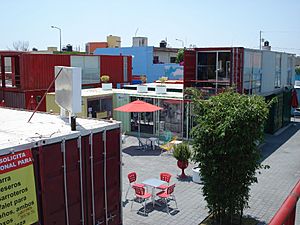
Half of the containers that enter the United States leave empty. Their value is lower in the US than in China. So, they are sometimes used for other purposes, often at the end of their shipping life. The US military often used its Conex containers for storage or as easy-to-move housing for staff and medical clinics. Most of the 150,000-plus Conex containers sent to Vietnam stayed there, mainly for storage. Using containers for permanent or semi-permanent storage is common. A regular 40-foot container has about 4,000 kg (8,818 lb) of steel. Melting this steel down takes a lot of energy. Reusing old shipping containers is a good way to help with both social and environmental problems.
Shipping container architecture uses old shipping containers as the main structure for modular homes. The steel can be part of the design or hidden to make a traditional-looking home. They have also been used to make temporary shops, cafes, and computer data centers.
Intermodal containers are not strong enough to be used as underground bunkers without extra support. Their walls can't handle much side pressure and would collapse. Also, the wooden floor of many used containers might have residues from chemicals used to treat them. This makes them unsuitable for enclosed spaces like bunkers without proper cleaning or replacement of the floor. You also need to pay attention to ventilation and insulation.
International Standards for Containers
Here are some important international standards for shipping containers:
- ASTM D5728-00: Rules for securing cargo in transport.
- ISO 668:2013: Rules for container types, sizes, and weights.
- ISO 830:1999: Words and terms used for freight containers.
- ISO 1161:1984: Rules for container corner fittings.
- ISO 1496: Rules for container specifications and testing.
- ISO 1496-1:2013: For general cargo containers.
- ISO 1496-2:2008: For containers that control temperature.
- ISO 1496-3:1995: For tank containers (liquids, gases, powders).
- ISO 1496-4:1991: For non-pressurized dry bulk containers.
- ISO 1496-5:1991: For platform and platform-based containers.
- ISO 2308:1972: Basic rules for hooks used to lift containers.
- ISO 3874:1997: Rules for handling and securing containers.
- ISO 6346:1995: Rules for coding, identifying, and marking containers.
- ISO 9897:1997: Codes for exchanging container data.
- ISO/TS 10891:2009: Rules for RFID tags on containers.
- ISO 14829:2002: Rules for calculating stability of straddle carriers (machines that move containers).
- ISO 17363:2007: How RFID is used for freight containers.
- ISO/PAS 17712:2006: Rules for mechanical seals on containers.
- ISO 18185-2:2007: Rules for electronic seals on containers.
More About Containers
 In Spanish: Contenedor para niños
In Spanish: Contenedor para niños
- BBC Box
- Boxpark Mall
- Conflat
- Container chassis
- Container ship
- Containerization
- Container port design process
- Customs Convention on Containers
- Double-stack rail transport
- GWR Container
- Inter-box connector
- Intermediate bulk container
- Logistics Vehicle System
- MIL-STD-129
- New York Central container
- RACE
- Re:START Mall
- Re-use
- Roller container
- Roll trailer
- SECU
- Shipping container
- Stowage plan for container ships
- Unit load


